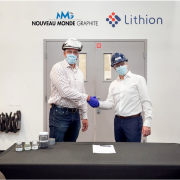Goal: Direct Recycling of Spent Batteries
Researchers of the German Karlsruhe Institute of Technology (KIT) and seven industry partners have launched a collaboration to develop a more efficient recycling process for spent batteries, by means of which the active components are recovered while maintaining their functionality.
According to KIT, electrification of the mobility sector is needed for Germany to reach its climate protection goals and a megatrend in the country’s automotive industry. “The associated high need for lithium-ion batteries requires sustainable and closed material cycles, from battery materials throughout the battery lifecycle to recycling as well as a closed cycle of battery cell manufacture,” Dr. Marco Gleiß from the Institute for Mechanical Process Engineering and Mechanics was quoted. He is KIT’s coordinator of the project “Agile Process Chain for Direct Recycling of Lithium-Ion Batteries and Regeneration of Active Materials” (DiRecReg), which is funded with nearly three million Euro by the Federal Research Ministry of Germany.
Recovering Rather Than Crushing or Decomposing
Using current methods, battery cells are crushed, and active materials are dissolved down to the molecular level for later extraction from the liquid in the form of metal salts, KIT described the general practice. In this way, up to 90 percent of critical elements, such as cobalt, nickel, and manganese, can be recovered. “However, consumption of energy and chemicals is very high. And even more energy and raw materials are required for the production of new battery material from the materials extracted.”
On the contrary, new, highly promising approaches were based on directly recycling active materials from spent batteries or production waste. As underlined, the active materials are no longer dissolved completely. Instead, they are decomposed into their constituents and separated mechanically so that highly pure fractions can be recovered.
Such a direct recycling process is not yet used in industry, as the behavior of the recycled material cannot be predicted, KIT wrote. Criteria and rules to assess the usability of the aged material were still lacking and so are economically efficient solutions to decompose different battery packs into their constituents with a reasonable expenditure. “These aspects are addressed by our project. It primarily covers the development of an agile process chain for the direct recycling of lithium-ion batteries and regeneration of the recovered active materials,” Dr. Thomas Dreyer from Weber Ultrasonics AG, project coordinator for DiRecReg, gave account. According to him, it is important that the process can be adjusted to various starting materials of battery production as well as to production waste and can be used to recycle various battery types and designs. “We also want to replace the energy-consuming steps of today’s recycling processes, the objective being to obtain sustainable recyclates of a high quality.”
The project consortium
The DiRecReg project is scheduled for a duration of three years. The project consortium under the direction of Weber Ultrasonics AG consists of ten partners and one associated partner. Among them are four institutes of KIT: wbk Institute of Production Science, the Institute for Mechanical Process Engineering and Mechanics, the Institute of Applied Geosciences with the Chair for Geochemistry and Economics Geology, and the Thin-Film Technology Working Group. The six industry partners are Battery cell manufacturer PowerCo SE, the materials technology and recycling group Umicore AG & Co. KG, the manufacturer of gripping and handling systems SCHUNK SE & Co. KG, plant integrator FIBRO LÄPPLE TECHNOLOGY GMBH, and plant manufacturers Carl Padberg Zentrifugenbau GmbH and Weber Ultrasonics AG. Siemens supports the project in the area of control and digitalization systems as an associated partner.
(Published in GLOBAL RECYCLING Magazine 3/2024, Page 34, Photo: )








